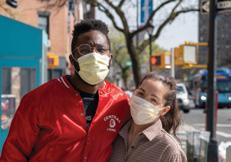
6 minute read
Key Recommendations for Behavioral Medicine and Counseling
VI. Key Recommendations for Behavioral Medicine and Counseling
This section of the Guide is designed to provide counseling professionals to support a student who is considering, taking, or returning from a leave of absence. It is a difficult decision for a student to make and requires thought, intention and commitment. Some students see their leave as an opportunity to engage in intensive care and treatment to build their wellness and resiliency. Other students use this time away to engage in meaningful work or life experiences to build skills and develop a greater purpose for returning to school.
It is critical that students design their own leave of absence plan and commit
to navigating their leave at their own PACE. To aid students, we recommend using the acronym PACE: People, Academics Skills, Care and Engagement to emphasize the critical domains of skills and strategies students may find helpful in building their wellness and resiliency to return. Key strategies to consider are on the following pages.
Help students identify their feelings and reasons for a leave of absence.
Encourage students to express their positive and negative feelings and reasons for taking a leave.
Conduct a simple pro/con list of taking a leave with a student. Normalize a “stop out” or “pause” to build wellness and resiliency.
Reframe students’ shame and position about a leave of absence as a decision of strength to promote their wellness and ultimately their academic and vocational success.
PREPARE STUDENTS TO TAKE A LEAVE
Provide students with a clear, concise checklist of steps they need to take to leave well. Include housing, visa status issues, financial aid, academic steps and insurance access issues.
Encourage student use of their Academic Advisors to discuss how a leave will affect their degree studies and how it will change their graduation date.
Encourage and assist students to know the implications of their financial aid, housing contracts, visa status when they take a medical leave.
Assist students in appeal processes for tuition and housing costs due to unexpected leaves.
Help students build a wellness plan that may include treatment while on a leave. Work to ensure that treatment is culturally and identity relevant.
Inquire about their financial and insurance resources to accomplish these goals.
continued on next page >
Utilize and share the PACE framework to build their plan while on leave: People, Academics,
Care and Engagement.
Encourage students to commit to the daily wellness strategies of sleep, nutrition and exercise/ mindfulness in supporting positive mental health. Encourage them to build a wellness toolkit.
Encourage students to build a daily structured routine while on leave that may include work, education, or community service into their plan.
Encourage students to build friendship connections into their plan.
Connect their wellness and resiliency to their goal of returning and finishing their college education.
Assure that student understands the health requirements needed to demonstrate to the university/college that they are ready to successfully complete their studies.
SHARE THESE RESOURCES TO GUIDE STUDENTS AND THEIR FAMILIES/SUPPORTS
Leave of Absence & Re-Entry Department or Contact: Some schools have offices that may be available to support a student through the processes of leaving, staying well and connected during their leave, and returning. You may want to connect the student with this office or individual for support navigating the University or College’s specific processes, policies, paperwork deadlines, and general expectations surrounding a leave and return from absence.
Access & Disability Services: This office provides services and support to ensure that all students are able to access and participate in the living and learning opportunities at school. If the student needs r classroom adjustments to support their learning or an advocate to co-navigate housing accommodations, you may want to connect the student with the disability & access office or coordinator.
Financial Assistance/Aid Office: Leaves of absences and withdrawals often have financial consequences for students. It is critical to encourage the student to connect with this office to understand their options and obligations as it relates to their leave and their return.
continued on next page >
Registrar: Some students find that taking a class during their leave of absence assists them to build a healthy structure and keep their academic skills sharp. Connect students to the registrar’s office to see if there are online options they can avail while on leave or if credits from another institution will transfer when they return from their leave.
Ombuds Office: Many colleges and universities have an Ombuds Office, which is an independent, impartial, informal problem-solving resource which maintains strict confidentiality and provides a safe place to have off-the-record conversations on issues related to life, work, or study. Talking to the Ombuds can be a good first step for students if they have a concern about their leave and/or their return.
Sexual Assault Response and Prevention Office: Many institutions have an office that provides rapid, confidential, supportive and free-of-charge advocacy and assistance to students who have experienced sexual assault, physical assault, interpersonal violence, and other crimes. These offices can be helpful with referrals to community resources when students are on leave and for preparing for their return.
Academic Advisors: A student’s academic advisor is a great resource to ask about majors and classes that are impacted by a leave of absence. They can be very helpful in planning for a return.
Dean of Students: The Dean of Students office at colleges and universities is committed to student personal and academic growth. In their offices, there are staff committed to helping students when they take a leave of absence and when they plan to return to the University.

Creating a culture of caring means helping students and families know there is no wrong door to enter through. Any department or office is the right place to start the journey.
continued on next page >
Provide coaching services that provide “at the elbow” support to students with mental health conditions maintain their wellness. Coaching is a highly solution-focused approach to help empower students with all facets of their life on campus. Coaching services can be flexible, mobile/ digital and brief encounters during the week. Coaching can be provided through counseling services, academic resource offices, peer support/coaching groups, athletic academic support offices, Offices of Access and Disability Services.
Utilize the PACE framework to use build and maintain wellness once students return to campus: People, academics, care and engagement.
Encourage students to commit to the daily wellness strategies of sleep, nutrition and exercise/ mindfulness in supporting their positive mental health. Assist them to build a Wellness toolkit for College.
Encourage students to build a daily structured routine for courses, homework, social time and self-care time.
Encourage students to participate in social activities that are a match for them.
Connect their wellness and resiliency to their goal of thriving, while they finish their college education.
Connect students to peer support groups in mental health, academics and identity affiliations. Students are already listening to one another. This is a way to assist them to find peer support that is critical.
Encourage continued use of telehealth services, campus therapy resources or local community resources. If referring students out to community clinicians, ensure they are able to utilize their campus insurance and be seen.
Offer wellness classes through first year programs, wellness offices, educational resource centers and counseling centers that target the critical intersection of mental health, wellness, academics, as well as therapeutic groups that build skills and create connections.






